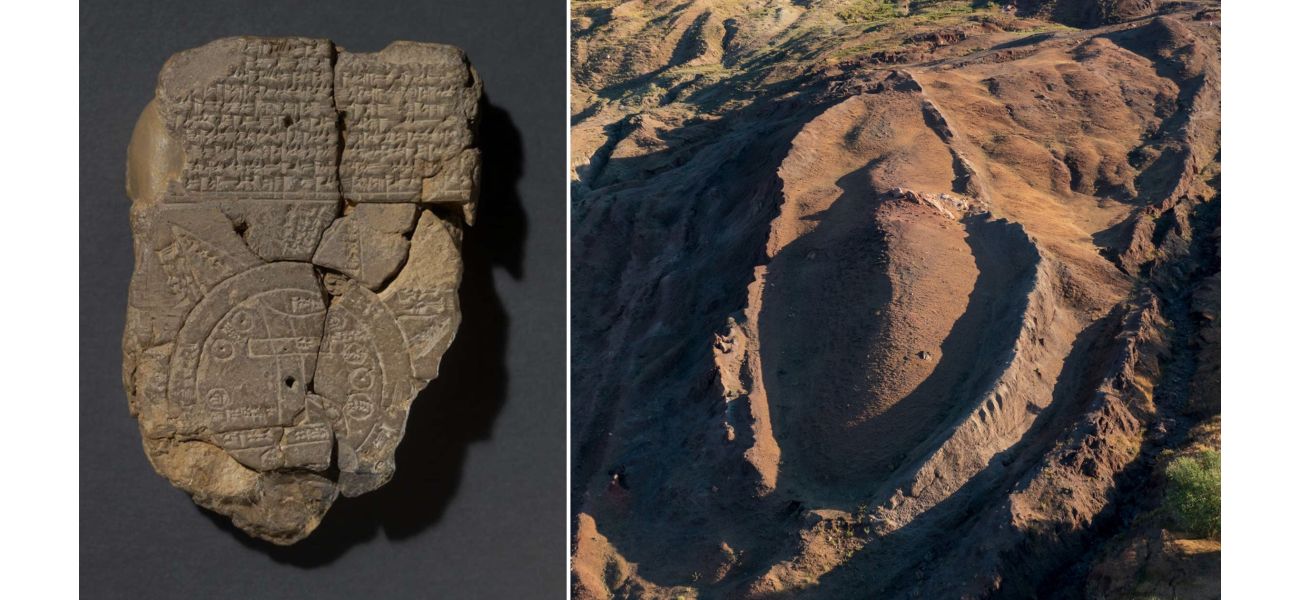Ancient map reveals where Noah's Ark may have been located, according to recent scientific study.
The tablet's back is like a guide, depicting sights on the traveler's journey.
October 29th 2024.

After years of research, scientists have made an incredible discovery - they believe they have found the resting place of Noah's Ark. It all started when they deciphered the world's oldest map, a 3,000-year-old Babylonian artifact known as the Imago Mundi. This clay tablet features a unique writing system that describes the creation of the world according to Christian beliefs.
At the British Museum, where the tablet is housed, researchers delved deeper into the map's meaning and were able to uncover biblical references hidden within the ancient cuneiform language. They found that the back of the tablet acted like a key, providing instructions for a journey. One portion of the map mentions passing through "seven leagues" to see something as large as a "parsiktu-vessel."
Further analysis revealed that the word "parsiktu" was also used on other ancient Babylonian tablets to describe the size of a boat needed to survive a great flood. Following the instructions on the map led researchers to the region of "Urartu," where an ancient Mesopotamian poem claims that Noah's family landed their ark to save humanity.
Finally, the puzzle of the world's oldest map was solved. It was thought that the Imago Mundi was pointing towards the remains of Noah's Ark, which was located in the Assyrian equivalent of "Ararat," the Hebrew word for the mountain where the biblical vessel was believed to have landed.
Dr. Irving Finkel, a curator at the British Museum, explained that the map showed the same story as the biblical account, but from a Babylonian perspective. He also noted that the map depicted the ark as a real, historical object - something that a traveler could see with their own eyes if they followed the journey outlined on the tablet.
The Imago Mundi was discovered in 1882 in what is now Iraq. It features cuneiform text, a language only used by the Babylonians, who etched a map of the entire known world at that time onto the tablet. At the center of the map lies Mesopotamia, surrounded by a circle representing a "bitter river" that was believed to encircle the entire world.
Although the tablet has been damaged, researchers were able to determine that it once featured eight triangles, which they believe represented mountains. These mountains matched the descriptions on the back of the tablet, which mentioned passing through seven leagues to reach the fourth mountain, where a giant vessel could be found.
According to Dr. Finkel, the cuneiform text also described the ark's dimensions as "thick parsiktu vessel." This measurement was only known from one other cuneiform tablet, which was also quite interesting, according to Dr. Finkel. He explained that this tablet was also a description of the ark, but from the perspective of the Babylonian version of Noah.
The Babylonian version of the story states that the god Ea sent a flood to wipe out humanity, except for Utnapishtim and his family, who were given the task of building an ark to save themselves and the animals. The ark was described as a "thick parsiktu vessel," and while the Imago Mundi dates back to 3,000 years ago, the biblical flood is believed to have occurred 5,000 years ago.
Dr. Finkel pointed out that anyone who followed the path outlined on the tablet would theoretically come across the remains of the ark on the mountain of Urartu, just like the one described in the Bible. According to the Bible, the ark settled on the "mountains of Ararat," which is located in Turkey, after a 150-day flood that destroyed all living things on Earth except for those on the ark.
Interestingly, the mountain in question has a peak that matches the shape and dimensions of Noah's ark, which was said to be 300 cubits long, 50 cubits wide, and 30 cubits high (equivalent to about 515 feet long, 86 feet wide, and 52 feet high). Excavations led by Istanbul Technical University have found evidence of human activity on the mountain dating back 3,000 to 5,000 years ago.
However, some have argued that Mount Ararat cannot be the location of the ark because the mountain was formed after the flood waters receded. Despite this, the discovery of the Imago Mundi and its connection to the biblical story of Noah's Ark is a significant achievement in understanding the origins of this ancient tale.
At the British Museum, where the tablet is housed, researchers delved deeper into the map's meaning and were able to uncover biblical references hidden within the ancient cuneiform language. They found that the back of the tablet acted like a key, providing instructions for a journey. One portion of the map mentions passing through "seven leagues" to see something as large as a "parsiktu-vessel."
Further analysis revealed that the word "parsiktu" was also used on other ancient Babylonian tablets to describe the size of a boat needed to survive a great flood. Following the instructions on the map led researchers to the region of "Urartu," where an ancient Mesopotamian poem claims that Noah's family landed their ark to save humanity.
Finally, the puzzle of the world's oldest map was solved. It was thought that the Imago Mundi was pointing towards the remains of Noah's Ark, which was located in the Assyrian equivalent of "Ararat," the Hebrew word for the mountain where the biblical vessel was believed to have landed.
Dr. Irving Finkel, a curator at the British Museum, explained that the map showed the same story as the biblical account, but from a Babylonian perspective. He also noted that the map depicted the ark as a real, historical object - something that a traveler could see with their own eyes if they followed the journey outlined on the tablet.
The Imago Mundi was discovered in 1882 in what is now Iraq. It features cuneiform text, a language only used by the Babylonians, who etched a map of the entire known world at that time onto the tablet. At the center of the map lies Mesopotamia, surrounded by a circle representing a "bitter river" that was believed to encircle the entire world.
Although the tablet has been damaged, researchers were able to determine that it once featured eight triangles, which they believe represented mountains. These mountains matched the descriptions on the back of the tablet, which mentioned passing through seven leagues to reach the fourth mountain, where a giant vessel could be found.
According to Dr. Finkel, the cuneiform text also described the ark's dimensions as "thick parsiktu vessel." This measurement was only known from one other cuneiform tablet, which was also quite interesting, according to Dr. Finkel. He explained that this tablet was also a description of the ark, but from the perspective of the Babylonian version of Noah.
The Babylonian version of the story states that the god Ea sent a flood to wipe out humanity, except for Utnapishtim and his family, who were given the task of building an ark to save themselves and the animals. The ark was described as a "thick parsiktu vessel," and while the Imago Mundi dates back to 3,000 years ago, the biblical flood is believed to have occurred 5,000 years ago.
Dr. Finkel pointed out that anyone who followed the path outlined on the tablet would theoretically come across the remains of the ark on the mountain of Urartu, just like the one described in the Bible. According to the Bible, the ark settled on the "mountains of Ararat," which is located in Turkey, after a 150-day flood that destroyed all living things on Earth except for those on the ark.
Interestingly, the mountain in question has a peak that matches the shape and dimensions of Noah's ark, which was said to be 300 cubits long, 50 cubits wide, and 30 cubits high (equivalent to about 515 feet long, 86 feet wide, and 52 feet high). Excavations led by Istanbul Technical University have found evidence of human activity on the mountain dating back 3,000 to 5,000 years ago.
However, some have argued that Mount Ararat cannot be the location of the ark because the mountain was formed after the flood waters receded. Despite this, the discovery of the Imago Mundi and its connection to the biblical story of Noah's Ark is a significant achievement in understanding the origins of this ancient tale.
[This article has been trending online recently and has been generated with AI. Your feed is customized.]
[Generative AI is experimental.]
0
0
Submit Comment





